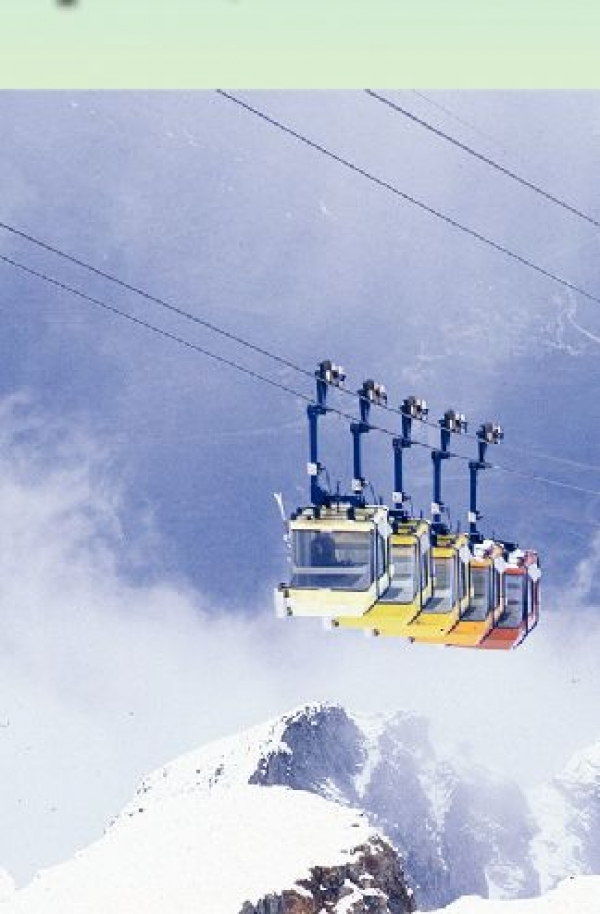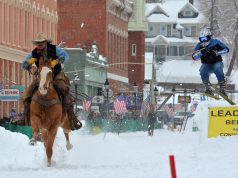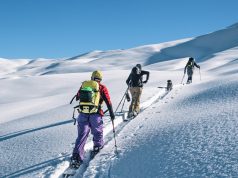
Over the past five years, fueled by concerns about sustainability, global warming and environmental footprints, and fed by the recent collapse in the real estate-fueled resort economy, skiers and snowboarders have started to become activists, creating a variety of nonprofits that seek to change the way that winter sports enthusiasts interact with both the environment and the surrounding resort communities.
One of these individuals is Jamie Schectman. Schectman is the founder of the Mountain Rider’s Alliance, and he’s taking an aggressive approach to how ski resorts are operated. As Schectman says, “One ski area has decided that us riders want heated chairlifts. I would rather that money be spent on clean energy development or something else dedicated to sustainability, not my behind.”
Schectman’s vision is powerful. He wants resorts to become energy-generation centers via solar and wind installation. He wants them to be community-based, with a focus on the long-term viability of the towns that surround them, and he wants them to offer up an affordable experience for all. A pipe dream? Maybe. But as sales for $2 million second homes dry up, and a dearth of affordable housing leads to a lack of a reliable workforce to staff the resorts, Schectman is starting to find people, including community leaders in places like Alaska and Canada, listening to him. Boulder Weekly caught up with him to ask him a few questions and find out more about his bold new vision for the mountains.
Boulder Weekly: What is the Mountain Rider’s Alliance?
Jamie Schectman: Mountain Rider’s Alliance is a group of skiing and snowboarding enthusiasts who are concerned about the environmental and economical future of the ski industry. For many of us, sliding on snow is much more than a sport, but rather a lifestyle.
BW: How did you get the idea for the MRA?
JS: My wife and I have both been involved in the ski industry and had yearly season passes since the 1980s. During this time, we have increasingly felt that the general operating model was focused on a short-term profit, instead of focusing on the local community, treating the mountain and employees with respect, and appreciating the skiers and snowboarders who love riding the mountains so much.
In our opinion, unfortunately, skiing has mostly become a rich person’s sport.
Additionally, climate change and fossil fuel dependency are real challenges that society is realizing it must face. We believe that if drastic actions are not taken, the future of our beloved pastime is in great jeopardy. We think that ski areas should co-exist with their environment, not depredate and exploit it.
We decided that instead of just complaining about the situation, we would become proactive by collaborating with others that share the same concerns and vision. Thus, Mountain Rider’s Alliance was created.
BW: Tell us a bit more about the ski industry. What are the problems you see in how the business has evolved?
JS: Relatively speaking, the sport of skiing is a young industry. In the earlier years, the industry focused on the ski experience. I love looking at those old school ski shots of people skiing powder with big grins, wool trousers and big, straight boards. In the ’90s, ski areas began developing more non-skier-centric amenities and evolved into real estate developers. During this time, in many locations, the actual ski experience didn’t improve, except for faster chairs, more extensive snow-making and increased mellow terrain for the second- and third-home homeowner. In fact, at many ski areas, there were more people skiing the same terrain, resulting in what I consider to be a declining overall mountain experience.
Fast forward to 2010, and the correction of resort real estate values, as well as rising operating costs (electric, insurance, etc.), have forced ski areas into having to generate more income to pay the bills. I think Hal Clifford’s Downhill Slide: Why the Corporate Ski Industry is Bad for Skiing, Ski Towns and the Environment was not only an amazing prediction of things to come, but a must-read for every ski area executive.
Focusing
on profit margins from two primary sources (skier visits and high
priced real estate) is placing the industry in a dangerous position in
today’s financial climate. By working together as a community, we have
the power to create positive change. Like cooperatives have shown in the
past with food co-ops or price-conscious access to good outdoor
clothing, collaboration can provide the platform needed to create
healthy ski areas. By involving the community, the riders, and
clean-energy economic principles, our community of snow lovers has the
chance to make a real difference.
BW:
Can you talk a bit about the state of the economy and the obvious
issues surrounding real estate development as an economic driver for
resort communities?
JS:
Well, I am no economist, but I feel that much of the current financial
crisis is as a result of over-consumption, i.e. people living outside
their means. This transcended into the ski industry in the form of
trophy homes and an abundance of slope-side accommodations bought on
credit. Since credit is no longer readily available, interest rates have
reset. And many areas have over-leveraged as resort property values
have plummeted, so there is now a serious problem. We believe that many
ski areas need to rethink their outdated business model, as it’s a whole
new world these days. If you look at a place like Whistler, which just
hosted the Olympics, they either need to expand to make more money, or
downsize, which seems unlikely. The status quo isn’t working anymore.
We
believe that MRA will greatly assist in the lifestyle of skiing and
snowboarding succeeding because it steps back from large loans being the
only source of financing. By involving clean energy
creation, offering reasonably priced shares to the global ski and
snowboard community, having minimal infrastructure that will reduce
operating costs, MRA is promoting a new type of sustainable ski area
model. By including multiple revenue streams, involving tax deductions
and grants promoting green businesses, removing typical high overheads
and developing partnerships with the ski community and townships, MRA is
hoping to erase the question that many in the industry are beginning to
ask, “Will we even have a ski industry in 50 years?”
BW: What projects and solutions is the MRA working on right now?
JS:
MRA is currently evaluating projects in Montana, Washington, Alaska and
British Columbia. Criteria include being located in a reliable snow
belt, having steep and exciting terrain (the ski industry doesn’t need
another intermediate ski area), offering solid clean energy options and
being surrounded by a community excited about the project. Each project
has its own set of pros and cons that will be assessed in order to make
the selection. We expect to announce which location will be the first
project in December of this year, with a detailed report describing the
various aspects of the proposed location.
MRA
is also developing partnerships with like-minded organizations and
corporations to build long-lasting, mutually beneficial relationships.
BW: How do these projects address the needs of the communities they are located in?
JS:
MRA believes a ski area should service the immediate and surrounding
communities. MRA will work with local nonprofit organizations to better
the lives of the locals. One example of practicing social responsibility
is working alongside one of our partners, SkiDUCK. SkiDUCK’s name is
derived from Skiing for Disabled and Underprivileged Kids. They are
dedicated to enriching the lives of disabled and underprivileged
children by sharing the joys of skiing and snowboarding.
MRA
also believes it is crucial to involve the community in the planning
process. If you look at some successful ski areas, public input was a
big part of the process. We believe the foundation of a successful ski
area is including the teachers, firefighters, waiters, ski bums,
instructors, patrollers, etc., into the mix. These are the people that
really depend on our ski areas succeeding. They are also the people that
know what is best for our mountain communities.
Besides
assisting in stimulating the local economy, we will also concentrate on
participating in clean-energy economic strategies, which will help the
community to become more environmentally conscious and reduce our
national carbon footprint.
BW: Who are some of your other partners?
JS:
Besides SkiDUCK, another nonprofit we are working with is Protect Our
Winters, which will be an invaluable asset for environmental awareness
issues, developing community-based projects and assisting with grant
writing.
Another
partner is Winter Wildlands Alliance, which also believes that the
snow-sports community needs to reduce our carbon footprint, especially
when accessing the back-country. They support ideas such as alternative
transportation, ride share options and carpooling. As well, they have a
robust climate initiative that will be implemented into the MRA business
model.
BW: Are you finding a receptive audience in the ski industry for your vision?
JS:
Yes, most definitely! It’s been very exciting, as we have been
contacted by people from around the world. We are receiving lots of
positive responses and e-mails from skiers, snowboarders and companies
interested in becoming more involved. Some of the ski message board
discussions have included skepticism, which is to be expected, and is
appreciated. We need devil’s advocates; it helps to identify possible
future flies in the ointment.
Additionally, the website is only meant
to outline the beliefs and vision, and to allow people to get an
understanding of what the movement is all about. The nuts and bolts,
financials and more specific details will be included in the actual
business plan for each project that will be available to review before
investment shares will be offered.
BW: Give us a bit of background on how you became involved in skiing.
JS:
After I graduated high school in 1987, I decided to take a year off
before college to go skiing. I moved to Lake Tahoe and started skiing
daily at Squaw Valley. That year turned into 18 before moving to
Argentina with my wife and dog to explore the Andes. From my beginnings
as a lift operator to my years as an auditor and manager for one of the
resort hotels, I always wondered if what we were seeing as the “ski
industry” could become more values-based; a more involved and uplifting
part of the community that depends on it.
BW: And you live in Argentina right now. What’s that like?
JS:
It’s been a great five years. Being fully immersed in another culture
has taught me many valuable life lessons. We started several
international businesses here, in both Mendoza and Patagonia, and have
learned the far-reaching power of the Internet. I have met some
topnotch, quality people and developed some lifelong friendships. Not to
mention some of the best skiing I have enjoyed is here. Argentina will
always be close to my heart.
BW: Future plans?
JS:
We plan to relocate back to the U.S. next month to aid in the
development of Mountain Rider’s Alliance. We will initially be based out
of Tahoe. This upcoming winter we will be checking out perspective
project locations, initiating feasibility studies, making contacts and
developing partnerships and, most importantly, skiing a lot.
For more information or to become involved with the Mountain Rider’s Alliance, check out mountainridersalliance. com.
Respond: [email protected]














